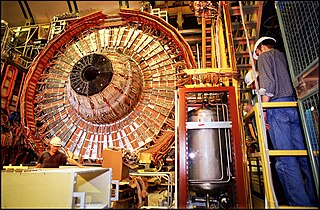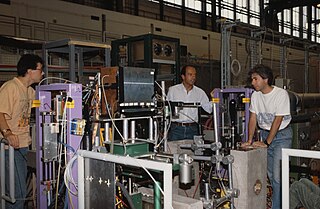
High-energy nuclear physics studies the behavior of nuclear matter in energy regimes typical of high-energy physics. The primary focus of this field is the study of heavy-ion collisions, as compared to lighter atoms in other particle accelerators. At sufficient collision energies, these types of collisions are theorized to produce the quark–gluon plasma. In peripheral nuclear collisions at high energies one expects to obtain information on the electromagnetic production of leptons and mesons that are not accessible in electron–positron colliders due to their much smaller luminosities.

DELPHI was one of the four main detectors of the Large Electron–Positron Collider (LEP) at CERN, one of the largest particle accelerators ever made. Like the other three detectors, it recorded and analyzed the result of the collision between LEP's colliding particle beams. The specific focus of DELPHI was on particle identification, three-dimensional information, high granularity (detail), and precise vertex determination.

ALICE is one of nine detector experiments at the Large Hadron Collider at CERN. The experiment is designed to study the conditions that are thought to have existed immediately after the Big Bang by measuring the properties of quark-gluon plasma.

CDHS was a neutrino experiment at CERN taking data from 1976 until 1984. The experiment was officially referred to as WA1. CDHS was a collaboration of groups from CERN, Dortmund, Heidelberg, Saclay and later Warsaw. The collaboration was led by Jack Steinberger. The experiment was designed to study deep inelastic neutrino interactions in iron.

The NA58 experiment, or COMPASS is a 60-metre-long fixed-target experiment at the M2 beam line of the SPS at CERN. The experimental hall is located at the CERN North Area, close to the French village of Prévessin-Moëns. The experiment is a two-staged spectrometer with numerous tracking detectors, particle identification and calorimetry. The physics results are extracted by recording and analysing the final states of the scattering processes.

Quark–gluon plasma is an interacting localized assembly of quarks and gluons at thermal and chemical (abundance) equilibrium. The word plasma signals that free color charges are allowed. In a 1987 summary, Léon Van Hove pointed out the equivalence of the three terms: quark gluon plasma, quark matter and a new state of matter. Since the temperature is above the Hagedorn temperature—and thus above the scale of light u,d-quark mass—the pressure exhibits the relativistic Stefan-Boltzmann format governed by temperature to the fourth power and many practically massless quark and gluon constituents. It can be said that QGP emerges to be the new phase of strongly interacting matter which manifests its physical properties in terms of nearly free dynamics of practically massless gluons and quarks. Both quarks and gluons must be present in conditions near chemical (yield) equilibrium with their colour charge open for a new state of matter to be referred to as QGP.

NA61/SHINE is a particle physics experiment at the Super Proton Synchrotron (SPS) at the European Organization for Nuclear Research (CERN). The experiment studies the hadronic final states produced in interactions of various beam particles with a variety of fixed nuclear targets at the SPS energies.

The NA62 experiment is a fixed-target particle physics experiment in the North Area of the SPS accelerator at CERN. The experiment was approved in February 2007. Data taking began in 2015, and the experiment is expected to become the first in the world to probe the decays of the charged kaon with probabilities down to 10−12. The experiment's spokesperson is Giuseppe Ruggiero. The collaboration involves 308 participants from 33 institutions and 16 countries around the world.

The NA49 experiment was a particle physics experiment that investigated the properties of quark–gluon plasma. The experiment's synonym was Ions/TPC-Hadrons. It took place in the North Area of the Super Proton Synchrotron (SPS) at CERN from 1991-2002.

Kim Sun-kee is a South Korean physicist. He is professor in Seoul National University and director of the Korea Invisible Mass Search. He was the first director of the Rare Isotope Science Project within the Institute for Basic Science and is a member of the Korean Academy of Science and Technology.

The WA89 experiment (Omega/Hyperon) was a particle physics experiment operating from 1989 to 1994 in the West Area of the SPS accelerator at CERN. It was a large acceptance forward spectrometer dedicated to the spectroscopy of charmed strange baryons and exotic multiquark states produced by a hyperon beam.

Maria Fidecaro (1930-2023), née Cervasi, was an Italian experimental physicist with a focus on particle physics. She has spent most of her career at CERN, where she after retirement had the status of honorary member of the personnel.

The WA70 experiment was a collaboration between the Universities of Geneva, Glasgow, Liverpool, Milan and Neuchatel using the facilities of the OMEGA spectrometer at CERN.

Emanuele Quercigh is an Italian particle physicist who works since 1964 at CERN, most known for the discovery of quark-gluon plasma (QGP). Quercigh moved as a child to Friuli with his mother and his younger brother after the early death of his father. Quercigh studied physics at the University of Milan in Italy, where he became assistant of professor Giuseppe Occhialini in 1959.
Reinhard Stock is a German experimental physicist, specializing in heavy-ion physics.
Yogendra Pathak Viyogi is an Indian physicist at Indian National Science Academy. He is specialized in the field of experimental nuclear physics.
"It is certainly a matter of great pride for all of us to be a part of the discovery of anti-alpha, the heaviest anti-matter to have been seen in terrestrial experiments."

The Underground Area 6 (UA6), also referred to as PHOTONS, experiment was a high-energy physics experiment at the Proton-Antiproton Collider, a modification of the Super Proton Synchrotron (SPS), at CERN. The experiment ran from 1984 to 1990, with the purpose of studying inclusive electromagnetic final states and lambda production in proton-antiproton and proton-proton interactions. Towards the end of its run it focused more on direct-photon and J/ψ production. The experiment is complementary to the UA1, UA2 and CDF experiments.

The Underground Area 7 (UA7) experiment was a high-energy physics experiment at the Proton-Antiproton Collider, a modification of the Super Proton Synchrotron (SPS), at CERN. The purpose of the experiment was to measure the invariant cross section of photons and neutral pions (π0) emitted close to zero degrees, by using silicon shower detectors. The experiment data taking ran from 1985 to 1986, and the final analysis was completed in 1996.

The Underground Area 9 (UA9) experiment is a high-energy physics experiment using particle beams from the Super Proton Synchrotron (SPS), at CERN. The purpose of the experiment is to investigate how using tiny bent crystals could allow the collimation of beams in modern hadron colliders to improve. UA9 was approved in 2008, and is in-progress as of 2013.
Photon Multiplicity Detector (PMD) is a detector used in the measurement of the multiplicity and spatial distribution of photons produced in nucleus - nucleus collisions. In short form, it is denoted by PMD. It was incorporated in the WA93 experiment. The funding for research and development of the design of PMD was done by the Department of Atomic Energy (DAE) and the Department of Science and Technology (DST) of the Government of India. The detector was constructed in the collaboration of Variable Energy Cyclotron Centre in Kolkata, Institute of Physics in Bhubaneswar and group of universities at Chandigarh, Jaipur and Jammu.













